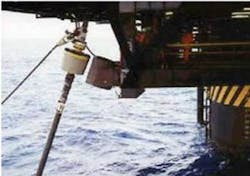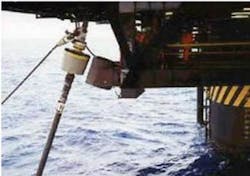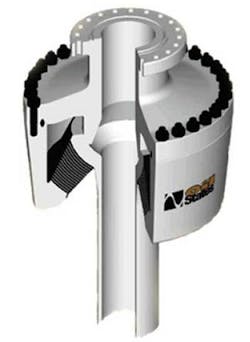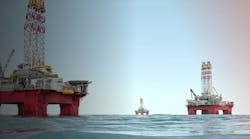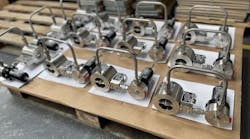Complete operating parameters should be defined before unit is designed
Steve Groves - BPMike Hogan, Scott Moses, Ralph Dean - Oil States Industries, Inc.Frank Hartley - Offshore Magazine
Flexible joints (FJs) are being used in more challenging applications now than when they first received industry acceptance in the 1990s as decoupling agents between steel catenary risers (SCRs) and floating platforms. Because of this and some instances of leaks, FJs are under re-examination and refinement of the design parameters, design philosophy, fatigue evaluation techniques, and elastomer performance.
Recent events focused attention on Oil States Industries’ (OSI) FlexJoint technology in SCR applications, and identified unrecognized operating loads and illustrated the importance of operating temperature, pressure, and pressure cycling on FlexJoint performance.
As a result, OSI made a number of enhancements to the FJ design over the last few years. One challenge was to minimize the elastomer stress in an operating FJ. High shape factor flex elements with multiple thin pads reduce the elastomer loading and increase the fatigue life.
Another advance in FJ design is incorporation of features to allow operation in a high-pressure/high-temperature (HP/HT) environment. The addition of thermal barriers, patented bellows, and other thermal isolation techniques reduce thermal exposure of the innermost layers and provide protection from rapid decompression in gas service. In addition, the company’s computational fluid dynamics analysis of HP/HT FJ designs shows that present thermal protection measures can limit the elastomer temperatures to 82°C (180°F) with internal fluid temperatures as high as 138°C (280°F). A collaborative effort between the FJ purchaser and the manufacturer must be made to assure that any FJ fulfills the performance and service life objectives for which it is designed.
Elastomer behavior
Even though OSI can explain qualitatively the damage observed on FJs using existing design techniques, a greater understanding of the performance capabilities and limitations of the elastomers used for FJs is needed. One goal is the ability to accurately relate elastomer behavior and failure modes observed under laboratory conditions to results in full-scale FJs. To this end, the company initiated a Joint Industry Program (JIP) to conduct an elastomer test program to establish a more accurate correlation between elastomeric fatigue failure in FJs engineering finite element analysis (FEA) models, and small specimen testing techniques. This effort will extend the understanding of temperature, pressure, and aging effects on FJ elastomers, with the intent of verifying the relationship between small-scale test techniques, full-scale test results, and analytical models
This JIP, chaired by BP, is about half done with its two-year program of work, and has begun to get a more thorough understanding of FJ failure modes and the influence of temperature and pressure cycles on FJ performance.
BP uses flexible joints as articulated connections for fluid carrying pipes/risers, e.g. production, drilling, and export risers, and for structures, e.g. riser towers. FJs reduce bending loads in the steel components, allowing engineers to design those components with adequate fatigue life.
While initial applications primarily were confined to TLPs, as new development concepts were introduced, the FJ was found to be effective on mini-TLPs, semisubmersibles, FPSOs, spars, and SPM buoys. To meet this variety of installation situations, service conditions, environmental considerations, and requirements, OSI designed and qualified FJs with new configurations and materials.
In the Gulf of Mexico, recent issues with FJs all involved SCRs. In this application, there are few proven alternatives to FJs, especially where a large constant diameter bore (to enable pigging) and high angular flexibility (up to 20°) are required.
Industry alerts
The Mineral Management Service (MMS) report of leakage from an oil export SCR FlexJoint on a GoM TLP in May 2004 caused great concern. The operator took immediate action to investigate the leakage, and discovered visible deterioration of both the oil and gas export FJs on the 1996-installed platform.
Subsequent MMS and OSI alerts to all GoM operators led to the inspection of about 50 in-service FJs. One operator found two oil/gas export FJs installed on a TLP in 1993 had visible indications of damage, but without major deterioration. Additionally, one of two export FJs installed on a spar in 2003 also displayed signs of early damage.
Like all operators, BP expects an FJ to maintain mechanical integrity and low stiffness over the life of the field. The typical minimum target life used for design is the life of the field (including all envisioned load cycles experienced during that service life) multiplied by a safety factor of 10. The predicted design life of any riser component normally is much longer than the 250 or 300 years that result from this safety factored design. The apparent failure of several FJs to meet these requirements has, therefore, been the subject of a great deal of industry activity.
Failure investigations
Each of the five damaged FJs underwent separate, detailed investigations by teams formed from operators, partners, the MMS, and OSI. Recognizing the potential impact on use of the SCR for oil and gas production activities, these teams aimed to identify the mode of failure and the potential causes of damage. Consensus opinion concluded that failure was due to progressive cohesive elastomer fatigue as a result of axial loading to the FJs over a period of months or years. The initial leak from the oil export FJ was due to a severe level of deterioration which disrupted its structure and led to a leak path between two or more of the reinforcements in the flex element. Although minor leakage had occurred, the mode of failure was structurally fail-safe, and did not lead to loss of support of the riser.
In an attempt to isolate the cause of the failures, OSI considered and evaluated the following potential causes:
- Manufacturing procedures
- Quality control
- FJ design process
- Material selection
- Elastomer behavior
- Actual service conditions
- Environmental factors.
Audit of the design, manufacturing, and quality assurance documentation revealed no errors, oversights, or negligence in fabrication of the FJs. Environmental factors such as external temperatures and fluid exposure were in line with anticipated conditions and did not account for the type or extent of elastomer failure. Elastomer selection for the FJs conformed with accepted material selection practices at the time of design and fabrication. These conclusions were supported by the fact that almost 50 FJs operating in the GoM showed no evidence of failure. This included two FJs of identical design to some damaged units. Eliminating these factors meant evaluation of the detailed service conditions for individual SCR FJs took on greater significance.
Pressure pulsations, temperature
Analysis of the detailed historical operating data from operators showed that export FJs are often subjected to pressure pulsations when those FJs are part of a large gathering system. Although the exact levels and frequency of these pulsations are unpredictable, investigation of historic records on several GoM operations indicates the magnitude may reach ±10% of the rated pipeline pressure at 15 to 60 minute intervals. OSI and operators concluded that the superimposition of this level of pressure fluctuation on the original fatigue histogram dramatically impacts elastomer fatigue life.
The same historical data showed that one of the damaged FJs had been subject to significantly higher temperature than any other. This reinforced laboratory tests which identified operating temperature as a potential trigger for FJ deterioration.
Capturing service conditions
A key lesson drawn from the export FJ damage is the importance of capturing all potential service conditions when preparing the design. By taking an active role in reviewing potential service conditions, the manufacturer can provide the best assurance that all long-term performance objectives can be met. A design process that simply assigns a safety factor to compensate for inconsistencies in field conditions cannot give these same assurances. During riser design, the industry needs to consider in detail the temperature, absolute pressure, and pressure cycling ramifications, in addition to the typical fatigue considerations.
At the same time, OSI recognized there were no reported failures of high-pressure riser FJs. Although pressure fluctuations may be present in import risers, the company says the magnitude and frequency are smaller in proportion to the rated design pressure. Furthermore, import SCRs generally operate at a smaller fraction of their design pressure compared to export SCRs, essentially resulting in a conservative design.
Avoiding operation issues
Of the almost 50 FJs used atop SCRs in the GoM over the last 10 years, only five have had to be replaced. As discussed, the failure investigations and the OSI JIP have given new insights into FJ design and operation.
OSI and operators redesigned the FJs before they went into service, where the project schedule has allowed the incorporation of this new information.
When units are in service, operators intend to minimize severity of the service seen by FJs. BP, for example, fitted oil export coolers onto three of its deepwater GoM facilities to reduce the temperature which oil export FJs see while in-service. BP inspects all its FJs on a regular basis. This inspection demonstrated that early detection of damage is feasible through visual inspection by diver or ROV. Other inspection methods are under investigation.
If damage is discovered in its early stages, it gives the option to continue safe operation for a period of time while replacement is arranged. BP also assesses the impact of operations on the FJs. This is done through key performance indicators (KPIs) which are part of its on-going riser integrity management programs. These KPIs look at the impact of operating conditions on FJ life through analysis of comprehensive day-to-day operating data.
OSI and the major operators are committed to continue working to gain a better understanding of the FJ design and performance within the OSI JIP, and through additional related testing and analysis work.
Editor’s Note:This is based on a summary of a DOT paper presented in Vitoria, Brazil Nov. 8-10, 2005.
